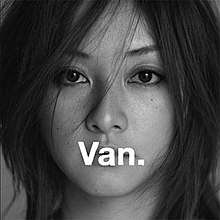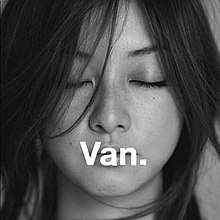Van (album)
Van. is the fourth solo album and second original studio album from Japanese singer Tomiko Van. It was released on December 10, 2008 and contains the title tracks of all four of her solo singles, as well as two b-sides and five new tracks, for an overall total of eleven tracks.[1]
| Van. | ||||
|---|---|---|---|---|
 | ||||
| Studio album by | ||||
| Released | December 10, 2008 | |||
| Recorded | 2006-2008 | |||
| Genre | J-pop | |||
| Label | Avex Trax | |||
| Tomiko Van chronology | ||||
| ||||
| CD + DVD | ||||
 | ||||
Track listing
CD
- Catalog number: AVCD-23712
- Flower
- Utopia
- manacles
- Brave
- Yumeji (夢路; Dream Road)
- carry out
- Senkou (閃光; Glint)
- message.
- Tokyo Biyori (東京日和; Tokyo Weather)
- Refrain
- Van. (Instrumental Track)
DVD
- Flower
- Senkou
- Yumeji
- Tokyo Biyori
- Flower (a-nation)
Charts
| Chart | Peak position |
Sales | Time in chart |
|---|---|---|---|
| Oricon Weekly Albums | #28[2] | 8,852 | 4 weeks |
gollark: What?
gollark: Okay, ||Emu Warrior|| achievement is in.
gollark: Maybe I could add some feature where you can share your achievement somehow.
gollark: It's meant to be vaguely stupid.
gollark: No.
References
External links
- mu-mo page (in Japanese)
This article is issued from Wikipedia. The text is licensed under Creative Commons - Attribution - Sharealike. Additional terms may apply for the media files.